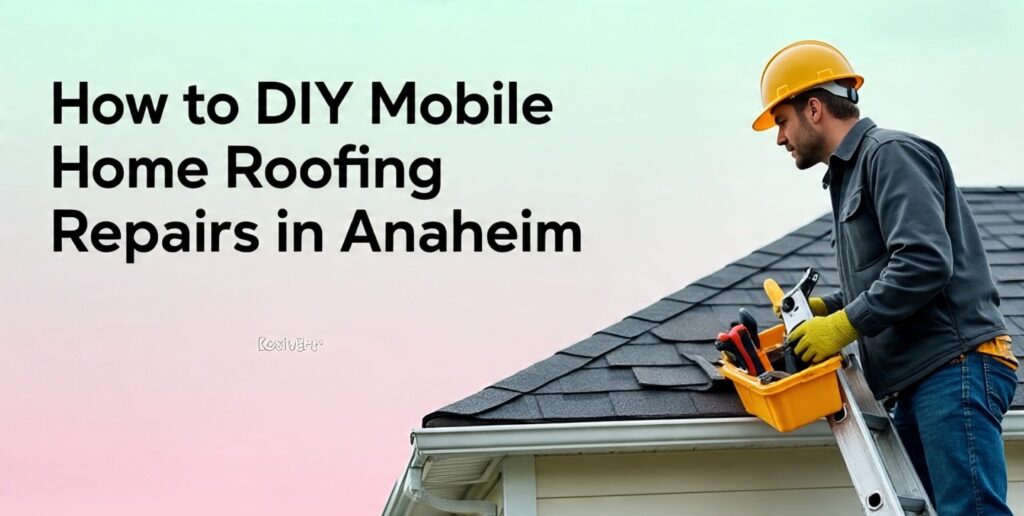
Mobile Home Roofing
If you’ve just noticed a drip above your kitchen table or a suspicious stain creeping across your ceiling, you’re probably wondering, “Can I actually fix my own mobile home roof?” Don’t panic—tackling roofing repairs yourself isn’t impossible, even if Anaheim’s sun and coastal breezes have left your home’s shelter a little worse for wear. In fact, with some patience, a little prep, and a focus on safety, you can absolutely patch up that mobile home roof without calling in the pros. Just remember—no roof is worth risking your neck, so let’s talk about how to handle DIY mobile home roofing repairs in Anaheim safely.
1. Key Features: What Makes Mobile Home Roofing Unique?
Before you even grab a ladder, it helps to know what you’re working with. Mobile home roofs aren’t quite like the ones you see on two-story houses. They’re usually flatter, lighter, and made from materials that are a bit easier to work with if you’re handy. Most roofs on mobile homes in Anaheim are either metal or rubber membrane, with some older ones using asphalt shingles. Each of these has its own quirks—metal can dent or rust, rubber might develop cracks, and shingles can lift in the Santa Ana winds.
Here’s a quick breakdown so you know what you might be fixing:
| Roof Type | Common Issues | DIY-Friendly? |
|---|---|---|
| Metal (Aluminum or Steel) | Leaks at seams, rust, loose panels | Yes, with the right sealants |
| Rubber Membrane (EPDM/TPO) | Cracks, punctures, seam separation | Yes, patch kits available |
| Asphalt Shingle | Missing/lifted shingles, leaks, granule loss | Yes, but requires more tools |
Knowing what’s up there helps you plan your approach and buy the right supplies before you even start.
2. Safety: Your Top Priority on the Roof
If there’s one thing to take seriously, it’s safety. Trust me—slipping off a roof is a fast way to turn a small repair into a big hospital bill. Before you do anything, give your ladder a good inspection (no wobbles!), and always set it up on level, solid ground. Shoes with good grip are a must; no flip-flops or sandals, even if it’s 90 degrees outside.
Once you’re up there, work slow and steady. Don’t stretch too far—move your ladder instead. If you can, ask a friend or family member to spot you from below or hand up tools. And of course, if your roof feels soft or saggy, that’s a red flag—don’t risk it! Call a professional, because hidden damage can mean the roof won’t hold your weight.
“The best tool for any DIY project is a healthy dose of caution—because you can always fix a roof, but you can’t fix a broken bone so easily.”
Keep the weather in mind, too. Anaheim’s sunny days are great, but heat makes metal roofs slippery with sweat and can soften some materials. Early mornings or cooler afternoons are usually safest.
3. Cost: What to Expect When You Fix It Yourself
One reason a lot of folks grab their toolbelt is to save money. So, how much will this set you back? Most DIY mobile home roofing repairs are surprisingly affordable if you already have some basic tools like a caulk gun, hammer, or putty knife.
Here’s a ballpark for what you might spend:
- Basic sealant or patch kit: $20–$50
- Replacement shingles or panels: $30–$100 (depending on area)
- Roll roofing or membrane: $50–$200
- Safety gear (gloves, shoes, harness): $25–$75
Compare that to a pro roofer, who might charge $300–$800 for a simple patch, and doing it yourself definitely looks good for your wallet. Just don’t cheap out on safety equipment or quality materials—you’ll save yourself a lot of headaches later.
Pro tip: Take photos before and after repairs. Not only does this help if you need to show your insurance, but it also helps you remember what you did for next time.
4. Emergency Service: When DIY Isn’t Enough
Sometimes, things go sideways—like when a branch crashes through during a storm, or you discover way more damage than you expected. If water is pouring in, or you see big cracks or holes, don’t try to handle it all yourself. Your main goal is to keep things as dry as possible until help arrives.
You can use a tarp and some heavy rocks or boards to cover the area—this buys you time and protects your home’s interior. After that, call a local emergency roofing service in Anaheim. Many offer 24/7 help and can stop by quickly, even if it’s just to stabilize things until a bigger repair is possible.
A little preparation goes a long way. Keep some heavy-duty tarps and duct tape in your shed just in case; you’ll thank yourself when the next unexpected storm hits.
Conclusion: You’ve Got This!
Fixing your own mobile home roof can be empowering—and even a little fun, once you get the hang of it. The keys are knowing your roof’s material, putting safety above all else, budgeting for the right supplies, and knowing when to call in the cavalry. Remember, not every leak needs a pro, but every repair needs your full attention and a careful approach. With a little patience and the right attitude, anyone in Anaheim can take on basic mobile home roofing repairs and keep their home safe and dry.
Read More: Anaheim Roofing


